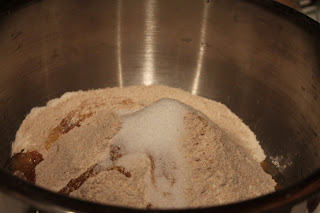 |
| Two Loaves; Photocredit: Servia |
I checked Jeffrey Hamelman's Bread out of the library. I've haven't been hearing much good news from Graduate Schools and so I thought it would be a fun distraction. As it turns out, I may even buy a copy of the book because so many of the recipes appeal to me.
One that caught my eye for it's simplicity was the Oatmeal Bread.
Oatmeal Bread (Adapted from Hamelman's Bread)
Ingredients:
- 680g High-Gluten Flour
- 227g Whole Wheat Flour
- 150g Rolled Oats
- 567g Water, around 75 degrees F (I added another 50g or so because it's very dry here)
- 100g Milk
- 68g Honey (3T)
- 68g Vegitable Oil (5.5T)
- 20g Salt (3.5tsp)
- 5g dry active yeast (1.5tsp) I reduced this to 1tsp because I was worried about leaving it too long in the refrigerator because I had class this morning. I think the decision was wise and I highly recommend it.
- Wheat bran and water for topping (optional)
Directions:
- Mix the oats and the water. Let it sit for 15-20 minutes.
- Mix in the remaining ingredients (yeast first, in order to hydrate it). The dough can be mixed by hand or on a mixer at a medium low speed for 3 minutes. The resulting dough is tacky and looser than a typical sandwich bread.
 |
| Other Ingredients; Photocredit: Servia |
- Then, knead the dough by hand (using the heals of the hand in the typical kneading style) either in the bowl or on a surface (either oiled or very lightly flowered). By hand, this will take 5-6 minutes to create moderate gluten development (passes the windowpane test). The same effect can be achieved in a mixer for 3-3.5 minutes on medium speed.
 |
| Dough, rising; Photocredit: Servia |
- Then let the bread ferment for 1 hour at room temperature (around 72 degrees F) folding once at 30 minutes and once at the hour mark. If you decided to use the full 1.5tsp yeast, you may want to leave it out for 40 min and do a fold at 20 and a fold at 40.
- Put the bread, covered in plastic wrap or similar, into the refrigerator overnight. Note that if you don't want to take it out first thing in the morning, I would suggest that you use less yeast just so it doesn't overproof.
- Remove the bread from the refrigerator. Turn the bread out on to a floured work surface and divide into 2-3 pieces (I would suggest 3 pieces if you have regular loaf pans, 2 if you have large loaf pans) I divided it into four, and my loaves are quite small; my mistake.
- Preshape the dough lightly into rounds.
- Bench rest the dough seem-side up for 15-20 minutes.
- During the bench rest, prepare loaf pans. I use spray oil and then coat them lightly with flour. This might be overkill-- oil alone might do the trick.
- Shape the dough into blunt cylinders and place them seem-side down into the loaf pans.
- Let them rise for 1-1.5h under plastic wrap or similar at 72-75 degrees F Mine rose for 3h15 at around 68 degrees F, but they only had 1tsp yeast. Make sure you adjust based on your conditions. If you only use 1tsp yeast, increase the time to 150%. If the temperature is cold, remember that for every 17 degrees below temperature, the rising time must double. A calculator is your friend.
- Optional: When ready to bake, brush the top of the loaves with a tiny bit of water and then sprinkle wheat bran over the top for that finished look.
- Put them in the over at around 445 degrees F (420 convection) understeam for the first 15 min. Then add about 7-10 minutes at 425 degrees F (400 convection) without steam. Watch them carefully. I overcooked mine by putting them there for 20 min + 10 min without steam. The oil and honey causes them to brown really fast. For steam, you can either try putting the baking pan on a stone with a cover or you can turn another loaf pan upside-down on top of it. They are done when they read 190 degrees F on an instant thermometer.
- Wait at least 1 hour before cutting.
 |
| Photocredit: Servia |
 |
| Slices and Loaf; Photocredit: Servia |
*NOTE (02/12/13): While I still think the bread is far too light, I have to say it tastes delicious with almond butter (so my original complaint was totally wrong).
For the similarly oat-obsessed out there, here's a list of other yeasted oat confections I've made:

Tried my sample this am toasted....almond butter great with it!
ReplyDelete